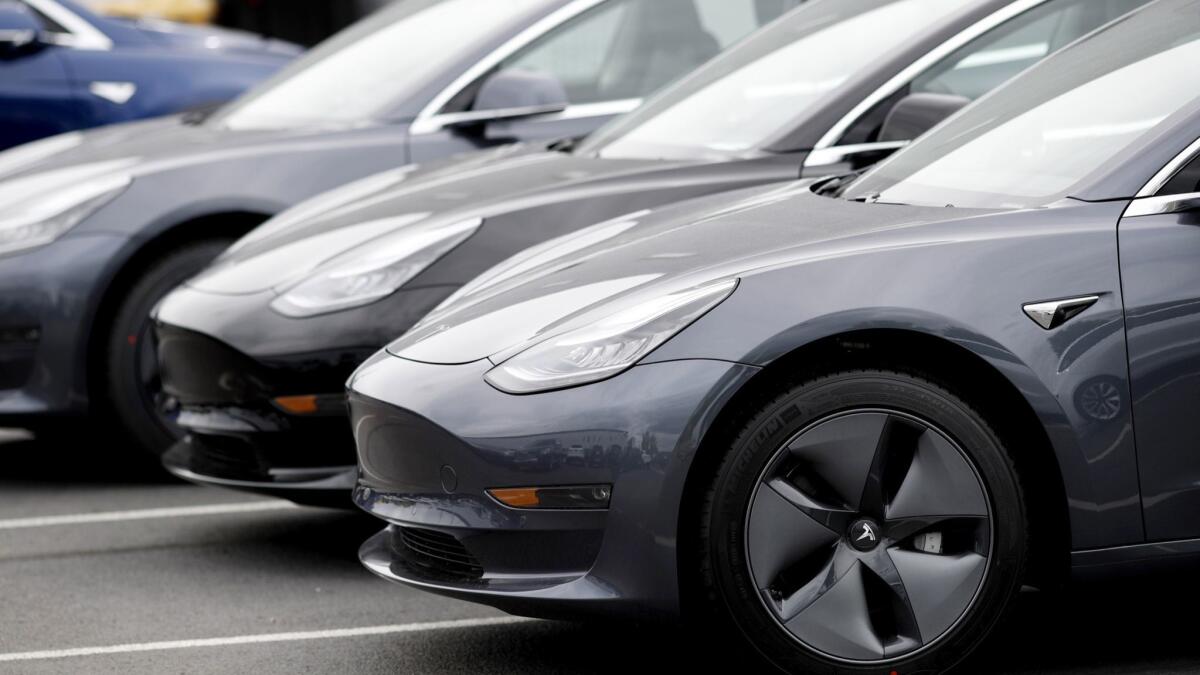Elon Musk’s quest for Tesla deliveries record could be a double-edged sword

To understand why investors have soured on Tesla Inc. this year, consider one of the thousands of deliveries that took place last week as the electric-car maker was gunning for a record for the number of vehicles it handed over in a quarter.
John Hanna, who splays his fandom for Elon Musk’s companies on his Twitter profile, ordered a Model 3 on Tuesday evening and drove it home the following afternoon. He paid about $69,000 for a Performance version of the sedan, and the Denver-area store he picked it up from was bustling with buyers.
A devoted customer paying handsomely for a new car might seem far from worrisome. But since 2015, the telecom executive had been driving a Model S, sales of which have started slumping after years without a major redesign. Hanna was waiting to buy a refreshed version of the Model S but sold his car to a private party — and got the high-end Model 3 instead.
The potential cannibalization of higher-end Model S and Model X sales by the cheaper Model 3 gives Wall Street pause. Analysts keep cutting their price targets for Tesla’s stock, and even after a 21% rally in June, the shares are down 31% for the year.
Wall Street relented from more downbeat expectations for Tesla deliveries in the last few weeks after Musk downplayed demand concerns at Tesla’s annual shareholder meeting and in emails to employees. On average, analysts expect Tesla to report this week that it delivered just over 87,000 cars this quarter. That would be a big bounce back from the disappointing first three months of 2019, but still short of the record that Tesla set at the end of last year and its forecast for at least 90,000. Tesla’s big push over the final days of June will determine whether it surprises the Street and beats its previous record.
Analysts’ fear is that even if Tesla does show marked improvement in deliveries this quarter, Musk will achieve this at the expense of profitability. And with a shrinking U.S. tax credit posing a threat to demand in the second half of the year, Tesla’s efforts to hand over more Model 3s overseas could further compromise earnings because of relatively higher shipping and other administrative expenses.
“I would short it. We are shorting it,” Alexander Roepers, founder of Atlantic Investment Management, said of Tesla’s stock on Bloomberg Television. The hedge fund has $1.5 billion under management. “If they achieve margins like General Motors on 2021 earnings and trade at a multiple twice General Motors, they should drop 55% from here,” he said of Tesla.
Before turning 48 on Friday, Musk wrote to Tesla staff that they could set a new record for deliveries if they were to “go all out” as the quarter came to a close. He tweeted that his birthday plan was far from exotic: He’d spend it working on Tesla logistics.
Tesla has said it expects to deliver 360,000 to 400,000 cars in 2019, but handed over just 63,000 in the first quarter. That’s heaped pressure on the company to ramp up its delivery operations both at home and abroad.
The whims of government incentives for electric-car purchases have complicated matters. Canada initially exempted Tesla from a $5,000 rebate it started offering to other battery-powered models on May 1 because the Model 3 was too expensive to qualify. The company started offering a cheaper, shorter-range version that’s now eligible.
Analysts and customers alike point to the Canadian incentive, a $3,750 federal tax credit in the U.S. and demand from countries, including Norway and the Netherlands, as reasons Tesla may have a shot this quarter at coming close to the record 90,700 cars the company delivered in the last three months of 2018.
“I’d be shocked if they come in below 89,000,” Hanna said. “I think North America is strong because of Canada, and Europe is strong. The real question mark is China.”
Tesla makes all of its vehicles at its lone auto assembly plant in Fremont, Calif., and while it doesn’t report vehicle sales by region, registration data suggest it’s still highly reliant on its home state for sales. Expenses associated with scaling up deliveries in China, where the company is building a car and battery assembly plant, set up a “challenging stretch ahead,” Bloomberg Intelligence analyst Kevin Tynan wrote in a report this month.
While there are reasons to be anxious about Tesla’s future, John Booth’s focus last week was on getting his Model 3 before the U.S. tax credit toward Tesla purchases shrinks to $1,875 as of July 1. The polygraph examiner took delivery of his car on Monday in Costa Mesa to more or less wipe out the cost of long commutes into Los Angeles.
“Only had the car for a few days, but everything so far is real nice,” Booth wrote in an email. He and his wife were one of about 10 couples picking up their cars on Monday. The staff at Tesla’s store “did a nice job, even with them being busy.”
Zach Nussbaum, 29, drove a Tesla for the very first time on Friday, when he picked up his blue Model 3 at a service center in Austin, Texas, and drove it home.
“The tax credit was important to me because it’s going to get cut in half,” Nussbaum said by phone. He has little regard for Tesla’s doubters: “I ignore the naysayers and I just listen to actual people who own the car.”
More to Read
Inside the business of entertainment
The Wide Shot brings you news, analysis and insights on everything from streaming wars to production — and what it all means for the future.
You may occasionally receive promotional content from the Los Angeles Times.










